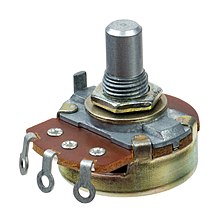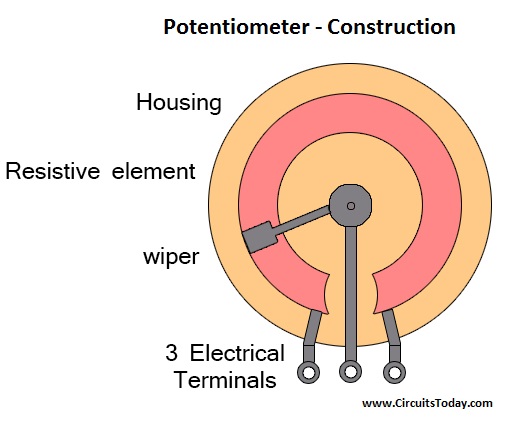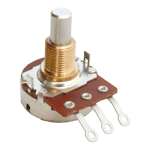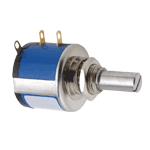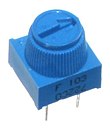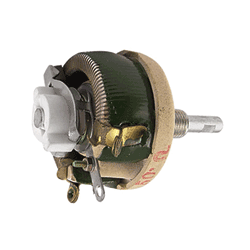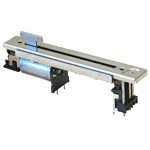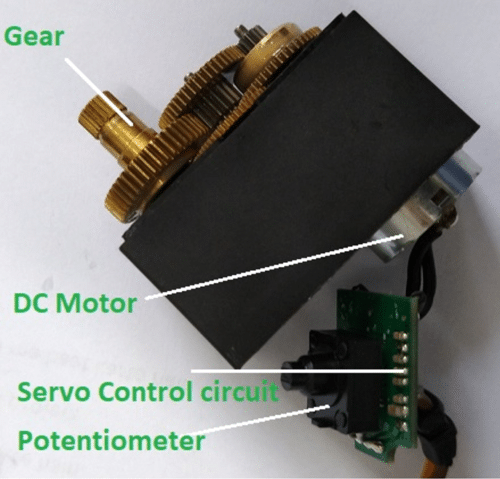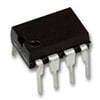Table of Contents
| Single-turn, rotary potentiometer [1] |
|---|
What is a Potentiometer?
A potentiometer is a type of variable resistor with three terminals, which creates a variable voltage based on its position [3]. The two outermost terminals are connected to the ends of a constant resistive element, which determines its resistance rating [2]. The central terminal is connected to an adjustable contact or wiper along the resistive element, creating a voltage divider [2]. The wiper outputs a variable voltage/electric potential based on its position along the resistor, hence its name [2]. If only two terminals are utilized, the wiper and one of the external terminals, the potentiometer acts like a rheostat—just a variable resistor, not as a voltage divider [3]. Potentiometers are also commonly referred to as "pots" for short [2]. Like regular resistors, potentiometers most commonly come in multiples of 10, 20, 22, 25, 47, and 50 ohms [2].
| Potentiometer internals [10] |
|---|
Types of Potentiometer
Typical Potentiometers
The most common type is the rotary potentiometer, where the wiper moves along a circular path, adjusted by twisting a knob, dial, or shaft [4]. Most rotary potentiometers are single-turn, rotating less than a full turn (~300 degrees), but multi-turn potentiometers can be rotated multiple turns for a greater rotational accuracy [2][4].
The slider potentiometer has the wiper sliding along a linear track, usually used for audio controls as the position of the wiper directly corresponds to its setting [2][4]. These are also known as "sliders", "slide pots", or "faders", due to this use [2].
A trimmer potentiometer, or "trimpot", is a potentiometer designed to be used on a PCB and set once or very infrequently for calibration [4][5]. They have a very small form-factor and are usually single-turn, though multi-turn variants exist to increase accuracy [5].
A rheostat is a variable resistor designed to limit the flow of significant current rather than adjust a voltage [6]. A common potentiometer can be used as a rheostat, but it is better to use a dedicated rheostat in higher power applications [6]. They are mostly obsolete due to their low efficiency compared to more modern switching solutions [6].
Electronically Controlled Potentiometers
Usually, potentiometers are manually adjustable, mechanical, and analog devices, but there are potentiometers that are motorized or digital.
For example, some servo motors use a potentiometer to determine their rotational position, where the alternative is a different component known as a rotary encoder [7]. Based on that, there are rotary and slider potentiometers that can be manually or automatically adjusted using a built-in servo motor [2]. This can be useful in audio equipment where the settings can loaded from saved values, as well as be manually adjusted [2].
A digital potentiometer is a solid-state device that acts like a mechanical potentiometer but controlled with digital signals [3]. They come in a variety of resistances, just like analog potentiometers. They are not a drop-in replacement, but they can usually be electronically configured in various ways using standard serial protocols [8]. Most digital potentiometers operate at 5V to power the component itself [8]. Additionally, they have a resolution dependent on the number of bits needed to control them, the most common being 8 bits, corresponding to 28 or 256 steps of resistance [8].
Single-turn rotary potentiometer [2] | Slide potentiometer [2] |
| Multi-turn rotary potentiometer [2] | Typical trimpot [9] |
| Rotary rheostat [6] | Motorized slide potentiometer [2] |
Potentiometer in a servo [11] | Digital potentiometer in DIP form factor [8] |
Potentiometer Taper
Potentiometers also have a resistance taper, the relationship between the wiper position and resistance ratio [12].
Most potentiometers have a linear taper, where the position corresponds linearly with the resistance ratio [12].
The most common non-linear taper is a logarithmic taper (actually following an exponential curve) in audio applications to compensate for the logarithmic nature of human hearing, which is beyond the scope of this page [12]. This allows the 100% position to subjectively sound twice as loud as the 50% position, which wouldn't be the case with a linear taper. Potentiometers with exponential tapers (following a logarithmic curve) exist but are uncommon.
Sometimes, slide potentiometers are referred to as "linear potentiometers" because of the linear track, but this can be confusing because a slide potentiometer can have a non-linear taper [12]. Like mentioned above, sliders for audio applications would have a logarithmic taper.
| Common tapers (dashed lines indicate an ideal logarithmic and exponential curve) [12] |
|---|
References
Contributors
| User | Last Update |
|---|---|
| Mayurakhi Khan | 1060 days ago |
| Former user (Deleted) | |
| Former user (Deleted) |
Faculty Advisors: Kim Pope, John Thistle, Allyson Giannikouris, Michael Lenover (alumni)
